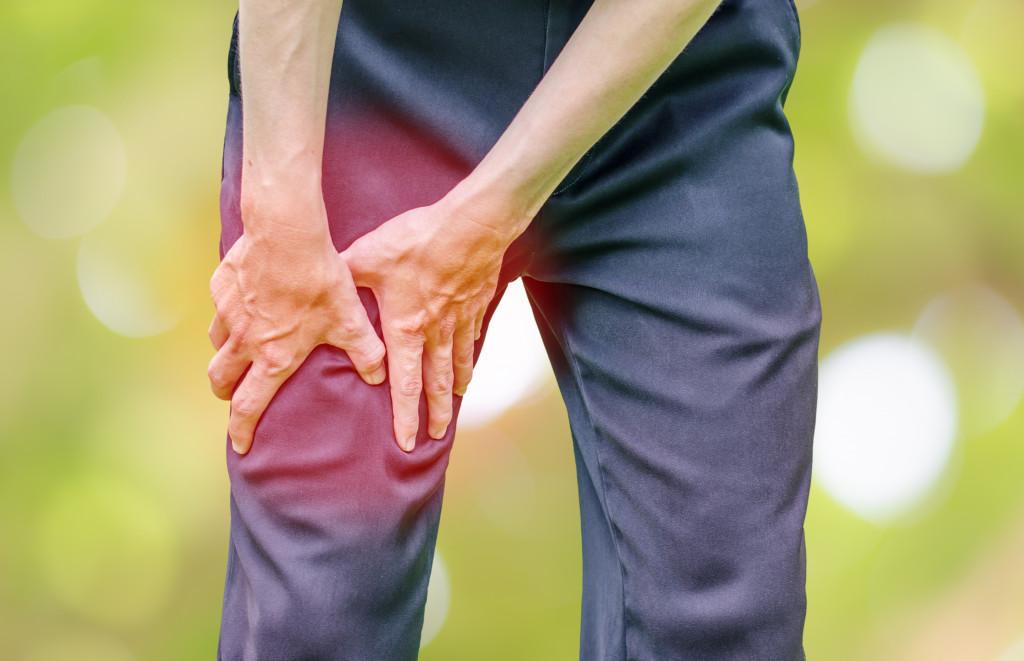- Knee tendonitis is an inflammation of the tendons around the knee joint caused by overuse or repetitive stress.
- Gout is a form of arthritis that significantly results in inflammation and intense pain.
- Patellofemoral pain syndrome involves a dull, aching pain around the kneecap and is caused by overuse, misalignment, or injury.
- Arthritis is a general term for conditions that cause inflammation and degeneration of the joints.
- Iliotibial band syndrome (ITBS) causes pain and inflammation on the outside of the knee.
Knowing the common diseases affecting your knees is crucial as an individual who values mobility and overall well-being. The knees are complex joints that bear significant weight and undergo constant stress. Unfortunately, several conditions can lead to pain, inflammation, and reduced mobility in this area. This guide will explore the five most common diseases that can affect your knees.
1. Knee Tendonitis
Knee tendonitis, also known as patellar tendonitis or jumper’s knee, is characterized by inflammation of the tendons surrounding the knee joint. It often occurs due to repetitive stress or knee overuse, such as jumping or running. Individuals involved in sports or occupations that require repetitive knee movements are particularly susceptible to this condition.
Symptoms of knee tendonitis include pain, tenderness, and swelling around the kneecap area. The pain may worsen with activity and improve with rest. To manage knee tendonitis, it’s essential to rest the affected knee, apply ice to reduce inflammation and perform appropriate stretching and strengthening exercises. In severe cases, medical intervention may be necessary, such as physical therapy or corticosteroid injections.
2. Gout

Gout is a form of arthritis that can affect various joints, including the knee. Gout attacks typically come on suddenly and are characterized by severe pain, swelling, redness, and warmth in the affected joint, including the knee.
The symptoms may subside after a few days, but without proper management, gout can recur and cause long-term damage to the joints. To manage gout, it’s crucial to make dietary changes, such as avoiding foods high in purines, which can contribute to uric acid production. Medications may be prescribed to reduce inflammation and lower uric acid levels. Maintaining a healthy weight and staying hydrated can also help prevent gout attacks.
3. Patellofemoral Pain Syndrome
The runner’s knee, or patellofemoral pain syndrome, is a prevalent condition that results in pain around the kneecap’s front. It often occurs due to overuse, kneecap misalignment, muscle imbalances, or a traumatic injury. People who regularly participate in activities that involve repetitive bending of the knees, like running or cycling, have a higher risk of developing this condition.
The symptoms of patellofemoral pain syndrome include a dull, aching pain around the kneecap, which worsens with activities like climbing stairs, squatting, or prolonged sitting. Treatment typically involves rest, ice, and over-the-counter pain medications to reduce inflammation and pain. Physical therapy exercises that focus on strengthening the muscles around the knee and improving biomechanics may also be recommended.
4. Arthritis
Arthritis is a broad term encompassing several conditions that cause inflammation and degeneration of the joints. Osteoarthritis, rheumatoid arthritis, and post-traumatic arthritis are the most common forms that can affect the knees. Osteoarthritis is characterized by the breakdown of cartilage, which cushions the joint, leading to pain, stiffness, and reduced range of motion.
Here are tips for managing your arthritis:
Get Active
Exercise is important for managing arthritis symptoms and can help reduce pain, stiffness, and swelling in the knees. Try low-impact activities like walking or swimming to increase your range of motion without putting too much stress on the joints. You can also participate in physical therapy sessions to learn exercises tailored to manage knee pain.
Reduce Stress

Stress can worsen arthritis symptoms, so finding healthy ways to manage stress levels is important. Incorporate relaxation techniques such as yoga, tai chi, meditation, or deep breathing into your routine. Talking with a counselor or therapist about your feelings can provide valuable insight and support for dealing with joint pain.
Eat Healthy
Eating a balanced diet can help reduce inflammation and improve overall health. Include plenty of fruits, vegetables, whole grains, lean proteins, and healthy fats to get the necessary nutrients to support joint health. Additionally, avoiding processed foods and added sugars can help keep your weight down and reduce pressure on the joints.
Seek Professional Help
Finding relief from arthritis symptoms can be difficult, which is why seeking professional help is essential. Utilizing professional arthritis treatment can help you manage your condition and reduce pain in the long run. A doctor can advise you on the best course of action and guide you on when to seek more intense medical interventions. In addition, they will offer treatments supported by research for knee pain that persists or happens repeatedly.
5. Iliotibial Band Syndrome
ITBS is an injury caused by overusing the iliotibial band, a thick band of tissue stretching from the hip to the shin and going over the knee. It is a common injury. It typically occurs in athletes or individuals who engage in repetitive activities like running or cycling. ITBS causes pain and inflammation on the outside of the knee, which worsens with activities and may even lead to a sharp, burning sensation. Rest, ice, and stretching exercises can help alleviate symptoms. Physical therapy may be beneficial in addressing underlying biomechanical issues contributing to ITBS.
Final Words
Awareness of common diseases affecting your knees is crucial for maintaining knee health and seeking timely treatment. Whether it’s knee tendonitis, gout, patellofemoral pain syndrome, arthritis, or iliotibial band syndrome, recognizing the symptoms and understanding the appropriate management strategies can help you address these conditions effectively. Consult a healthcare professional for an accurate diagnosis and personalized treatment plan. Taking proactive steps to care for your knee health, such as maintaining a healthy weight, engaging in regular exercise, using proper techniques during physical activities, and seeking prompt medical attention, can significantly contribute to your overall well-being and ensure the longevity of your knees.






